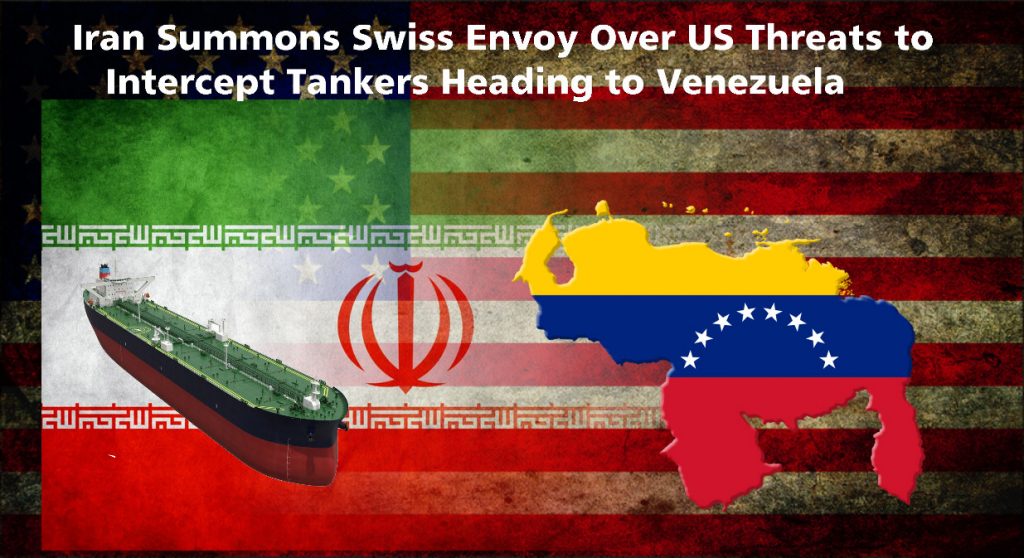
Iran summoned the Swiss ambassador, who represents U.S. interests in the Islamic Republic, over possible measures America could take against an Iranian fuel shipment to Venezuela, the Mehr news agency reported.
TankerTrackers.com, which tracks oil shipments and storage, showed the route of the suspect ships, which allegedly received gasoline at the port of Shahid Rajaee.
A senior official in U.S. President Donald Trump’s administration told Reuters on Thursday the United States was considering measures it could take in response to Iran’s shipment of five oil tankers headed to Venezuela.
A group of five Iranian tankers was previously spotted sailing through the Mediterranean Sea into the Atlantic Ocean and is believed to be heading towards Venezuela.
Iran’s Foreign Minister Javad Zarif has cautioned the US against intercepting or pursuing Iranian tankers sailing with a cargo of fuel towards Venezuela in a letter sent to UN Secretary General Antonio Guterres.
Zarif called the alleged plans to intercept the Iranian tankers “illegal, dangerous and provocative” acts that look very much like an act of piracy.
“Zarif also pointed out that the US government will be held accountable for any kind of illegal actions, stressing that Iran has the right to take the necessary steps to counter [US] threats”, a statement by the Iranian Foreign Ministry said.
Iran, Turkey and Russia are key allies to the Venezuelan regime of Nicolas Maduro. Both Iran and Turkey have received gold from the regime. Recently the price of oil has sharply declined, and Venezuela’s oil industry is facing a disaster – the Maduro regime having destroyed what was once a thriving industry. It is not entirely clear what is in the suspected ships heading for Venezuela, and it is not entirely clear they are all going to Venezuela because they don’t all declare their destinations.
However it appears to be refined products, such as gasoline, which Venezuela needs and which it apparently can’t refine itself. This would be an example of Iran shipping fuel half-way across the world to a country that is already energy rich but which has failed miserably to provide the basics for its people.
US officials said over the weekend they have a “high degree of certainty” that Maduro has been paying Iran in gold for the fuel. The US says it is preparing measures that can be taken. It is of interest that the port where the gasoline was reportedly loaded on the tankers was the site of a recent cyber attack, according to Iranian sources.
Iran’s Fars News, likely acting on information from the IRGC, reported on Saturday that four US Navy warships are in the Caribbean along with P-8 aircraft and elements of the VP-26 squadron operating from Jacksonville, Florida.
According to “information we received,” Tasnim says, the US has sent the USS Detroit, Lassen, Preble and Farragut. This information was already known on May 11 because the US Defense Department published photos of the littoral combat ship USS Detroit and the guided missile destroyers Lassen, Preble and Farragut with a P-8 conducting maritime security operations in the Caribbean.
The Farragut, with its 96 missiles, has already dealt with Iranian threats when it was with the US Fifth Fleet last year in the Persian Gulf.
The US warships are reportedly heading toward Venezuela while the Iranian tankers – named the Clavel, Faxon, Forest, Petunia and Fortune – are still traversing the Mediterranean. TankerTrackers.com put up an image showing the Fortune out front, having crossed through the straits of Gibraltar, with the Petunia behind and the Forest just leaving the straits.
The Faxon and Clavel are making slower process near Sicily. This will take them time to come within range of the US ships.
Iran’s navy has no way to really protect the tankers. In 2017 Iran promised it would try to send its warships to the Caribbean, but so far this threat has not materialized. Iran’s navy is relatively small, and it recently suffered an embarrassment as one of its ships shot another ship with a missile off the port off Jask.
However, Iran can respond to US pressure by attacking ships in the Persian Gulf or striking at US forces in Iraq or US allies and partners. This is how Iran has responded in the past.
It has not been explained what connection the cyberattack on the Iranian port where the ships were loaded has to the current crisis at sea. Iran had been trying to get the Shahid Rajaee Port online for greater production.
Iran’s IRGC is tracking four US warships in the Caribbean and says the US is using a P-8 surveillance aircraft in the area. This sets the stage for a clash at sea.




